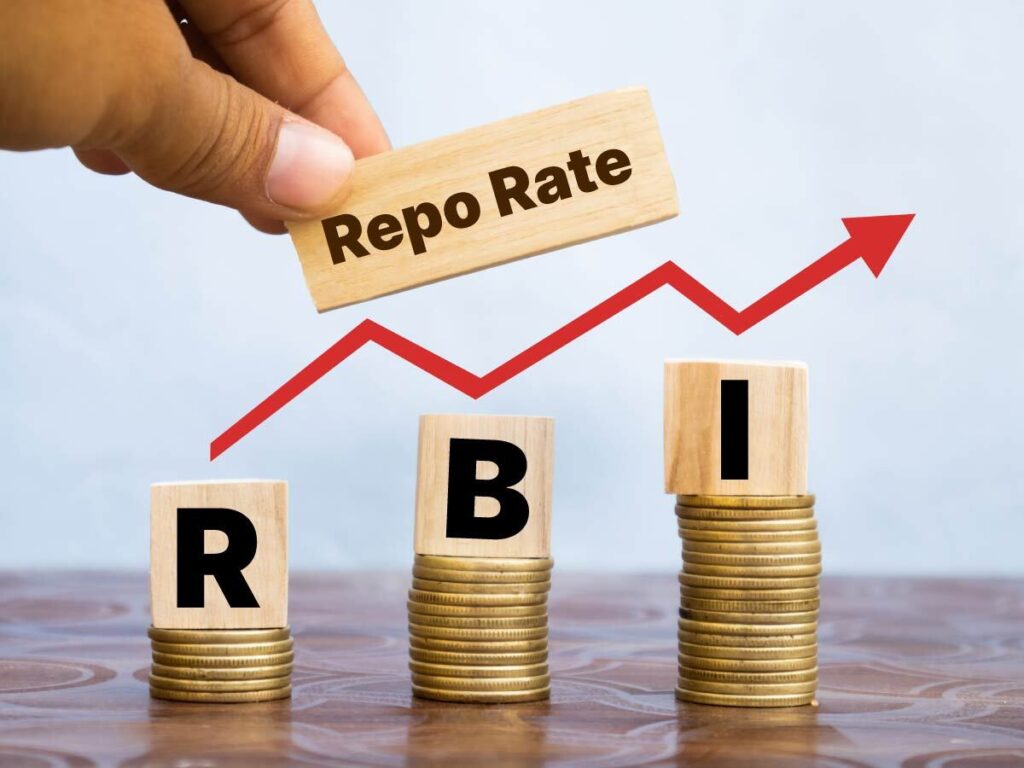The Monetary Policy Committee (MPC) announced on 8 June 2023 that the repo rate was increased by 25 basis points. This makes the current repo rate 6.50% as of September 18, 2024. (from the 6.25% that it was earlier).
The reverse repo rate stands unchanged at 3.35%.The Bank Rate and the Marginal Standing Facility (MSF) rate has changed to 6.75%.The Standing Deposit Facility Rate is 6.25%.

Repo Rate
The Repo Rate is the interest rate at which the Reserve Bank of India (RBI) loans money to commercial banks.
Repo Rate full form is Repurchase Agreement or Repurchasing Option. Banks obtain loans from the Reserve Bank of India (RBI) by selling qualifying securities.
The central bank or RBI and the commercial bank would reach an agreement to repurchase the securities at a set price. When banks are short on funds or need to maintain liquidity under volatile market conditions, this is done. The repo rate is utilized by the RBI to manage inflation.
How Does Repo Rate Work?
As previously stated, the repo rate is utilized by the Indian central bank to restrict the flow of money in the market. When the market is impacted by inflation, the RBI raises the repo rate.
An increased repo rate means that banks borrowing money from the central bank during this period will have to pay more interest. This inhibits banks from borrowing money, reducing the amount of money in the market and helping to negate inflation. In the event of a recession, RBI repo rates are also reduced.
What is BPS or Basis Point?
Basis points, also referred to as “bps” are a unit of measurement used in finance to express the rate of change in an index or other benchmark or the percentage change in the value of financial instruments. In decimal notation, one basis point is equal to 0.0001 or 0.01% (1/100th of a percent).
Current Repo Rate in India
The current Repo Rate in India has been fixed at 6.50% as per the announcement made by the government on 8th August 2024.
Reserve Bank of India Repo Rate
These are the latest Repo Rate and Reverse Repo Rate-
Repo Rate Today | 6.50% |
Reverse Repo Rate | 3.35% |
Bank Rate | 5.15% |
Marginal Standing Facility Rate | 6.75% |
Historical Repo Rates from 2024 to 2010
Period – Date Effective from | Repo Rates |
8th August 2024 | 6.50% |
7th June 2024 | 6.50% |
8th February 2024 | 6.50% |
8th December 2023 | 6.50% |
8th June 2023 | 6.50% |
8 February 2023 | 6.50% |
7 December 2022 | 6.25% |
30 September 2022 | 5.90% |
05 August 2022 | 5.40% |
08 June 2022 | 4.90% |
May 2022 | 4.40% |
09 October 2020 | 4.00% |
06 August 2020 | 4.00% |
22 May 2020 | 4.00% |
27 March 2020 | 4.00% |
06 February 2020 | 5.00% |
07 August 2019 | 5.00% |
06 June 2019 | 6.00% |
04 April 2019 | 6.00% |
07 February 2019 | 6.00% |
01 August 2018 | 7.00% |
06 June 2018 | 6.00% |
02 August 2017 | 6.00% |
04 October 2016 | 6.00% |
05 April 2016 | 7.00% |
29 September 2015 | 7.00% |
02 June 2015 | 7.00% |
04 March 2015 | 8.00% |
15 January 2015 | 8.00% |
28 January 2014 | 8.00% |
29 October 2013 | 7.75% |
20 September 2013 | 7.50% |
03 May 2013 | 7.25% |
17 March 2011 | 6.75% |
25 January 2011 | 6.50% |
02 November 2010 | 6.25% |
FAQs
What is the difference between repo rate and reverse repo rate?
The RBI charges a repo rate on the money it lends to commercial banks and other financial institutions while the interest rate that the central bank offers to commercial banks that deposit money in the RBI is the reverse repo rate.Reverse repo rate is never greater than repo rate.Repo rates assist in reducing market inflation.On the other hand,the reverse repo rate aids in regulating the amount of money available in the market.
What types of loans are impacted by the reduction or increase in repo rates?
A reduction or increase in the repo rate will affect loans like personal,vehicle,home,and gold loans.